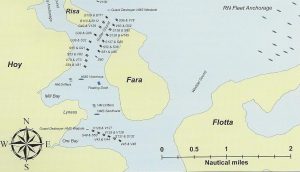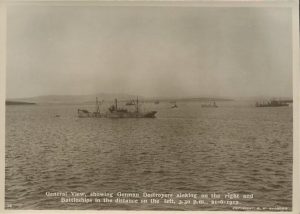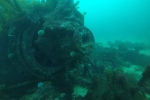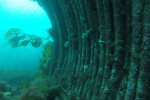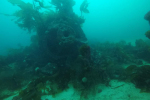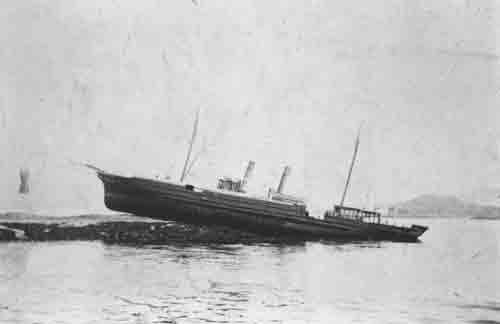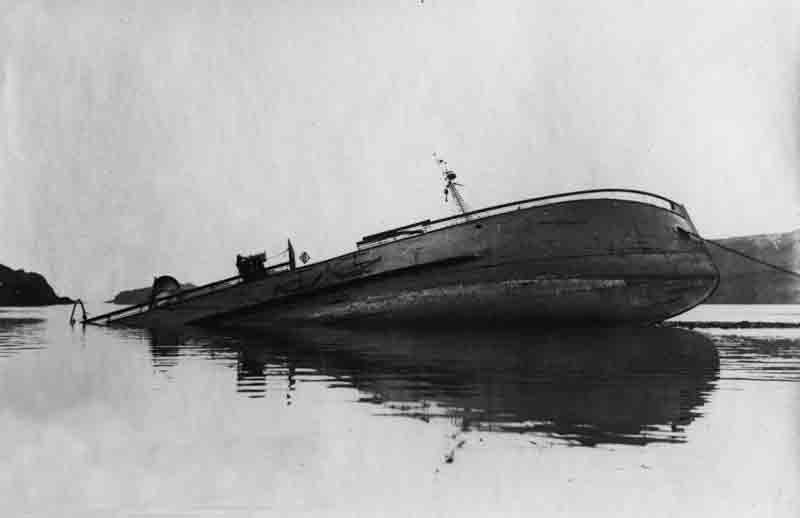The steel steam powered V-25 Class destroyer S-54 was launched from the yard of F. Schichau, Maschinen- und Lokomotivfabrik, Schiffswerft und Eisengießerei GmbH, Elbing (Yard No 944) on 11th October 1915. She measured 82.2 x 8.3 x 3.7 metres and displaced 919 tons. At the start of World War One the German Navy had 132 similar destroyers and a further 112 were completed and delivered during the war. The specifications varied slightly by shipyard but they had a similar configuration, armament and capability. S-54 was one of 135 similar vessels constructed by Schichau. Her powerful engines delivered 24000 shaft horse power driving twin propellers capable of a top speed of 34 knots. She was armed with 3 x 3.4 inch L/45 guns and 6 x 20 inch torpedo tubes and had a standard crew of 88 seamen.
On 22nd November 1918 S-54 joined 73 other warships of the German High Seas Fleet interned in the sheltered anchorage of Scapa Flow Orkney. She was anchored in Gutter Sound to the east of the island of Fara paired with the destroyer S–54. Coincidentally S-54 was moored alongside V-81 … the two destroyers were to suffer a very similar fate years later during the salvage operations. Seven months later, on 20th June 1919, Von Reuter’s flagship, SMS Emden, raised an unusual signal – the top flag was a white ball on a blue pennant, the lower one a yellow and blue pennant – the signal was answered by all the ships in the interned fleet. The signal aroused no suspicion and the next day, June 21st, the British First Battle Squadron and its escorting destroyers left Scapa on an exercise. The first signs that something was happening started to appear just before noon. Around the anchorage German sailors were lowering boats and leaving their ships. Reuter had ordered his fleet to be scuttled rather than let it fall into the hands of the Allied Navies. Attempts by the the British sailors remaining in Scapa Flow to stop the German vessels sinking were mainly unsuccessful but a few of the destroyers were beached or sank in very shallow water.
The largest ever underwater salvage operation began at the end of the war eventually removing all but seven of the vessels scuttled. The salvage began with the smaller destroyers before moving on to the larger capital ships. The details of S-54 salvage and subsequent stranding are somewhat vague on the historical record. She was purachsed by Cox and Danks in 1927 and the first attempt to raise her was made on 2nd October 1931. Apparently raised some time later, still in tact, she was patched up to be towed south to the breaker’s yard in Rosyth. It appears that, as she was being towed out of Scapa Flow, she drifted ashore south of Quoy Ness, Hoy. We have no record of subsequent salvage but it is certain that this took place, probably by Cox and Danks themselves.
The wreckage believed to be the remains of S-54 lie in position 58° 49.541’N, 03° 04.762’W. The broken remains lie in 14 metres.
